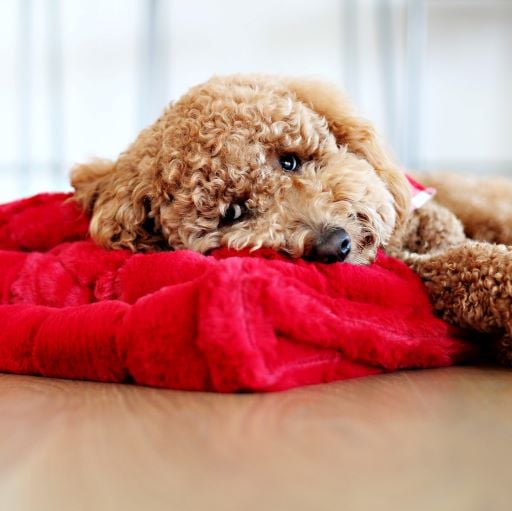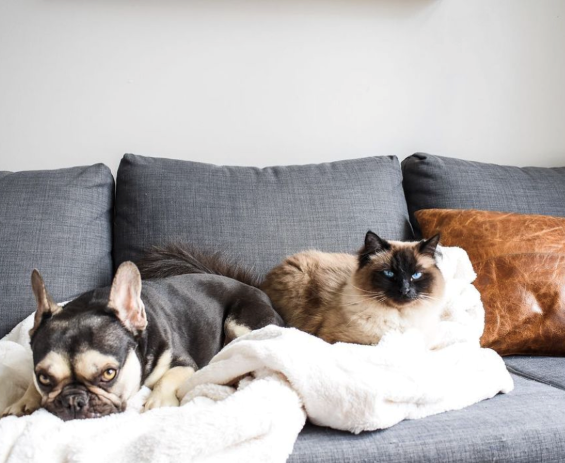Keep your furry best friends warm, happy, and healthy to share a magical winter season
With swirling snowflakes, pelting raindrops, and freezing weather, winter is not subtle in its arrival. When the cold season comes knocking at our door, we don an extra woolly layer, brew hot tea and burrow under warm blankets. But what can our dogs and cats do to stay warm? Not much on their own. Luckily, there are plenty of ways you can keep your beloved fur babies safe and cozy this winter.

How to keep your pets warm this winter
1. Dress your pets in warm clothing
A pooch or kitten sporting an adorable jumper is not only a heartwarming sight but also a well-cared-for animal. Jackets, coats, jumpers, and other winter clothing are designed to keep your fur babies warm and comfy when outside or on walks in the cold. Nowadays, you’ll find your pick of styles and designs both online and at pet stores. From jackets emblazoned with your favorite football team’s logo to raincoats with fun prints and witty statements, there’s something for everyone.
It’s important to choose winter pet clothing that doesn’t just look glamorous but is also practical and functional. Your dog or cat should be covered from the neck to the base of the tail, including the belly. The winter coat also needs to leave your fur baby ample space to breathe, stretch out, walk and run. Steer clear of anything with buttons, toggles, or dangling cords, as they can be easily broken and become a choking hazard. Immediately remove the warm layer once your pet is back inside or if it has gotten wet.
2. Provide a welcoming winter pet shelter
If your four-legged friend spends whole days or nights outside, it must have a warm and cozy refuge to retreat to. From the weather turning inclement or your pet needing a safe place to have a good sleep, dog and cat houses are a must-have for outdoor pets. To be happy in its kennel, your dog needs to be able to walk in and out comfortably, stand upright, turn around, and lay down flat with its legs stretched. The same is true for outdoor cat houses.
Outside pet homes should also be waterproof, windproof, and elevated from the ground. Turn the insulated shelter into a welcoming and cozy space with soft bedding and old blankets for your fur baby to snuggle into. Also, place a water bowl right by the entrance so they can stay hydrated without having to venture out of their warm shelter.
3. The great indoors
Unless you have a husky, samoyed, or another cold-weather dog breed, we can guarantee your pooch will be happy to snuggle up inside during winter. Even if your pup or cat loves to spend time outside the rest of the year, you’ll notice that they’ll stay out for a shorter period of time or come back in more often to warm up. Letting your outdoor pet sleep inside in winter is the best way to keep it safe and warm. See our article on How to Build a Comfortable Dog Bed with a Cozy Blanket for more information.
When spending more winter time indoors, make sure your fur baby still gets plenty of exercise. There are lots of physical games and enrichment activities for dogs and cats that will keep your pet stimulated and active with or without you present.
4. Soft, cozy pet bedding
Dogs love to snuggle up under blankets for their hard-earned naps. And the four-legged royalty residing with us, commonly known as cats, also love to curl up on soft and warm blankets. To help your pets stay warmer in winter, make sure their bed is away from drafts and either in an elevated position or well-insulated from the cold floor.
The same way you change the comforter for the chilly months of the year, swap your pet’s bedding for warmer, cozier blankets in winter. If your pet’s breed has short hair or you’ve just visited the groomer for a trim, consider adding another blanket or some pet-safe microwavable heat pads for extra warmth.
5. Winter grooming for pets
We might be tempted to let our cats’ and dogs’ coats grow long and full to keep them warmer in the colder months, but with the winter come puddles, mud, wet grass, and damp conditions. The fur of outdoor pets can quickly get dirty, knotted, and matted, making grooming more important than ever.
A good winter grooming routine involves brushing, bathing, shaving (done by professional groomers), and nail trimming. The latter is often overlooked for pets that usually go outside, but it might become a necessity if pets are stuck inside by, for example, snow. If you are giving your outdoor dog a wash, we recommend you bathe your pooch inside during winter, use warm water, and towel dry before allowing it back out.

Things pet owners should keep in mind in winter
Your fur baby’s behavior is likely to change slightly in winter, which might worry you if you don’t understand why. Look for these indicators to help you judge how your littlest family member is coping with the chilly temperatures.
1. Heat-seeking behavior
It’s entirely natural for your pet to change where they choose to sleep in winter. You might have spent summer stumbling over your cat sprayed on the cold hallway tiles, but you won’t find it there in winter. Instead, look for it on the carpet of a sun-filled room, on (or under) your favorite blanket, or inside a warm and cozy wardrobe. There’s no one better than a cat to show you the coolest and hottest spots in your home.
Dogs tend to love their bedding too much to leave it behind, but you might walk in one day to discover they’ve dragged it to a new, warmer spot while you were gone. Don’t be alarmed by these changes in their habits. Simply keep an eye on the situation, and offer a hand if they need your help to stay warm.
2. Appetite changes in winter
Should you feed your pet more, less, or the same in winter? With the temperatures dropping and longer nights, your pet will be less active. So it stands to reason we should feed them less. But our pets also need to increase their storage of calories and fat to survive the chilly months, which makes us think we should feed them more. That’s not all. The cold temperature and decreased daylight hours are proven to cause metabolic changes in your pet, increasing your fur baby’s appetite. So what should you do?
It depends on whether you have an indoor or outdoor pet. As Dr. Ken Tudor explains on PetMD, a dog exposed to low temperature needs two to three times the usual amount of food, while an indoor pet should be fed less.
3. Skin problems for dogs and cats in winter
During winter, your beloved pet might be more at risk of developing problematic skin conditions. From annoying matting to troublesome infections, the most common one is dry, itchy, and flaky skin. In dogs, it is mainly due to the daily changes in temperature and humidity they experience as they move from our warm homes to the cold outdoors, while in cats is caused by the low humidity in our heated homes. Regularly grooming your pet allows you to quickly pick up on any skin problems while they are still mild.
If you live in a state where it snows, use a towel to quickly clean your dog’s paws after a walk outside. This way, you’ll remove any snow or ice from their pads and wipe off any anti-freeze. Anti-freeze is very toxic to pets, so you don’t want your dog licking it off its paws or spreading it in the house.
Cuddle up and stay warm together
Winter can be a magical time of year, but don’t forget your fur babies when the temperatures drop. We might be biased, but we think that the best way to keep bodies and hearts warm this winter is with snuggly cuddles under a cozy Minky blanket!
Sewn with Love, Minky Couture


